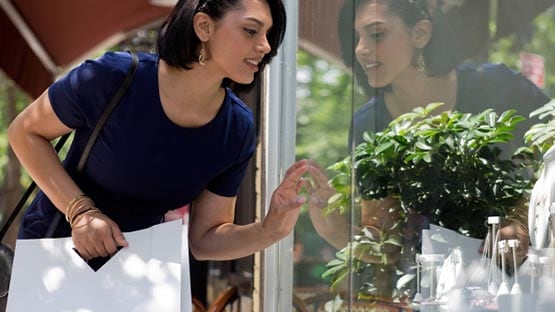
Online buying is rapidly becoming the norm for consumers in the Netherlands. More than 30% of Dutch respondents in PwC’s 10th annual Global Consumer Insights Survey (GCIS) said they make online purchases weekly or more frequently, putting habits in the Netherlands in line with the global average. The country’s young people are doing more shopping on their smartphones, too. But surprisingly, those 17- to 31-year-olds are still buying things at physical stores, even as digital tools affect what sort of experiences they expect to have there.
These are some of the main findings derived from PwC’s survey, which also shows that Dutch shoppers have a strong bias toward A-brands and aren’t quite the eco-friendly buyers they might think they are. When boiled down, the survey results point to one very clear takeaway: Technology has changed the relationship between customers and companies so significantly that consumers are now in the driver’s seat, and good shopping experiences are therefore more important than ever. PwC thinks companies need to start using a new customer-centred metric — “return on experience ,” or ROX — that takes this shift into account.
Mobile shopping catching on with younger shoppers
According to PwC’s survey, 17- to 31-year-old Dutch consumers are driving the rise in online shopping, particularly when it comes to using mobile devices. Of respondents in this age group, 28% said they use their smartphones to buy online every week; that’s twice as many as in the overall population (see Exhibit 1).
A trend toward mobile shopping could be wonderful news for consumer goods companies. In 2017, Italian online fashion retailer YOOX Net-a-Porter (YNAP) reported that for the first time, its online sales revenue from shoppers using mobile phones surpassed its online sales revenue from PCs and tablets, respectively. (Results from 2018 weren’t available at the time of publication.) And crucially, YNAP’s own research shows that its mobile customers buy much more frequently than its desktop customers and spend significantly more per year. It’s no coincidence, according to Enrico Cavatorta, who served as YNAP’s chief financial officer through January 2019. “By enhancing the customer experience at the layer that allows interactions with consumers — the web store, the mobile interface — YNAP finds that customers spend more time and money shopping with them,” Cavatorta told PwC in a January 2019 interview.
Overall, mobile shopping lags, but younger generations embrace it
Buying frequency on Mobile phone – total NL population vs. < 31yr old

Generation gap in delivery expectations
When it comes to shipping, Dutch consumers are much more parsimonious than their counterparts elsewhere. A whopping 36% of Dutch survey respondents said they’re not willing to pay for delivery, compared with just 16% globally. For retailers, this makes profitable operations more challenging. But the numbers are very different when you isolate particular demographics: the younger the Dutch shoppers, the more willing they are to pay for delivery. Only 11% of respondents under age 31 said they wouldn’t.
The PwC survey also shows how crucial it is for retailers to offer free returns and confirmed delivery dates for online sales. Almost half (43%) of Dutch respondents ranked these delivery attributes among the three that are most important to them (see Exhibit 2). Respondents under age 31 expressed a little less urgency. Just 35% ranked free returns in their top three and 36% prioritised knowing the delivery date when they place their orders.
For those speculating about how Amazon — known for its quick, convenient delivery and return options — will affect domestic retailers if and when it expands its offerings in the Netherlands, there’s no need to wait and wonder. PwC’s survey reveals that 37% of Dutch shoppers already buy from Amazon (and 48% of those under age 31). That’s up from 20% overall in the previous year.
Offering good in-store experience is crucial
Brick-and-mortar stores are still very much part of the picture in the Netherlands — even for millennials and their younger siblings. In fact, PwC’s survey shows that younger generations are shopping in-store even more frequently than older ones.
Because consumers, empowered by their smartphones, are already well-informed about what’s in shops and how much things cost, they’re looking for better experiences when they go to stores. For instance, PwC’s survey points out that shoppers of all ages value ease of navigation. Those ages 17 to 31 also have a particular interest in technology being embedded in the retail experience, including having access to quick and easy payment methods and good in-store Wi-Fi (see Exhibit 3).
Question: How often do you buy products in-store? Please do not include grocery shopping. Question: Which of these attributes would significantly improve your in-store shopping experience?
51+ years old
Sales associates: 54%
Ability to quickly and conveniently navigate through the store: 41%
Fun experience through store design or atmosphere: 33%
Use of technology to assist the shopping experience: 10%
17 to 31 years old
Quick and easy payment methods: 33%
Ability to quickly and conveniently navigate through the store: 30%
In-store Wi-Fi: 26%
Use of technology to assist the shopping experience: 18%
Introducing ROX
Considering the changes this year’s GCIS points out in consumer behaviours and demands, PwC believes that in addition to traditional return on investment (ROI) metrics, it’s time to introduce another metric — one focussed on measuring the returns companies get on the investments they make in customer experience (CX). A framework for this new ROX metric should connect customer experiences to employee experiences and bring together “softer” investments in culture with “harder” investments in technology and analytics.
ROX is unlike familiar scorecards and indices because it’s neither siloed nor static. It’s dynamic and systemwide, actively leveraging the interdependencies among existing business systems and highlighting the connections between multiple specific metrics that all contribute to the bigger ROX picture. Done right, ROX will spin up a virtuous cycle of benefits — and keep it spinning.
ROX can yield insights into which experiences companies should focus on and which “critical few” employee behaviours can most elevate experience and value from the customer’s point of view. And because ROX pulls in different metrics from different parts of the company, it can illuminate causal loops among them, modelling how shifts in any of them affect the others.
There are many ways an ROX leader might use data derived from measuring new things in new ways. And by shifting focus to customer experience, companies will be better able to recognise and reflect the influence of today’s digitally empowered consumer.
Explore the NL findings

A-brands
When the Dutch go shopping, they don’t usually gravitate toward the store-brand stuff. Typically, A-brand products are the first things they drop into their baskets. PwC’s 10th annual Global Consumer Insights Survey (GCIS) clearly shows their preferences.

Sustainability
There’s a perception that the Netherlands is a world leader in sustainability. But PwC’s 10th annual Global Consumer Insights Survey (GCIS) reveals that Dutch consumers actually lag slightly behind the citizens of many other nations when it comes to sustainable shopping habits.



















